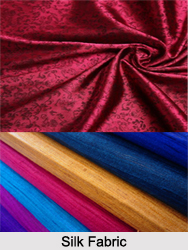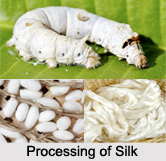 Silk, also known as "Paat" in East India, "Pattu" in South India and "Resham" in North India, is a natural fibre produced from the cocoons of mulberry silkworm via a process called Sericulture. Silk is said to be the "Queen of Textiles" and it has the charm that can hexes the elegance, luxury, comfort and class. The silk tradition is one of the oldest in India and sericulture is a labour concentrated industry. It demands nurturing of silkworms, which are exceedingly ravenous.
Silk, also known as "Paat" in East India, "Pattu" in South India and "Resham" in North India, is a natural fibre produced from the cocoons of mulberry silkworm via a process called Sericulture. Silk is said to be the "Queen of Textiles" and it has the charm that can hexes the elegance, luxury, comfort and class. The silk tradition is one of the oldest in India and sericulture is a labour concentrated industry. It demands nurturing of silkworms, which are exceedingly ravenous.
By its natural sheen and lustre, silk creates a spell in terms of grandeur and ethnicity. It has been maintaining its own qualitative mark in the Indian market despite of strict and daunting competition in the local market. The uniqueness of Silk Sarees lie in its traditional appeal combined with the light weight, dye in vibrant colours sometimes represent a blend of modern and traditional outlook.
Silk Production in India
As per the history, silk was introduced before 4,500 years and India is said to be the second largest producer of silk in the world. A pound of worms may exhaust a tonnes of mulberry leaves in a year. The production of silk is considered to be one of the major means of developing the economic status and foreign exchange of a country.
Karnataka, Tamil Nadu, Andhra Pradesh, Assam, West Bengal, Bihar, Uttar Pradesh and Madhya Pradesh are the states producing unprocessed silk. Among these states, West Bengal, Andhra Pradesh, Tamil Nadu, Karnataka and Jammu & Kashmir are reckoned for producing Mulberry Silk and Chhattisgarh, Odisha, Jharkhand, and north-eastern states are well recognised for producing Non-Mulberry Silks. In 1980-81 production of silk was 5,000 tonnes.
Types of Silk in India
Silk has many qualities which sets it apart from other fibres. In India there are five major types of silk are found as per economical important aspect. Silk is categorised in five main types namely Tussar silks, Oak Tussar, Eri, Mulberry and Muga that are distinguished for the different species of silkworms from which the silks are derived.
There are many other forms of Silk. The above mentioned are only some of major silks found in India. Silk is also classified according to their qualities such as; Raw silk, Wild Silk, Cultivated Silk, Thrown silk, Dupion Silk, Noil Silk, Reeled Silk, Spun Silk and Cut Silk.
Silk Sarees of India
The excellence in Silk Sarees of India evidences the expertise of the adept artisans and weavers of regions of India. The designs, the weaving technique, the use of colours that suit each and every design of silk sarees manifest the superiority of silks in India. Among the very popular Silk Sarees the names of Jamewar, Patola sarees, Navarangi, Paithani Sarees, Amru Silk, Kosa Silk, Chanderi, Maheshwari Silk, Sambalpuri Sarees, Bomkai Sarees, Baluchari Sarees, Ikat Silk. Apart from these sarees, South India has been recognised for heavy silk sarees namely Kanjeevaram Sarees, Kanchipuram Silks, Dharmavaram etc are sought after by people of not only that particular region but also the entire India and abroad as well.





















